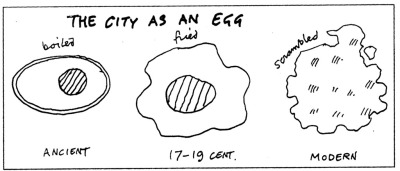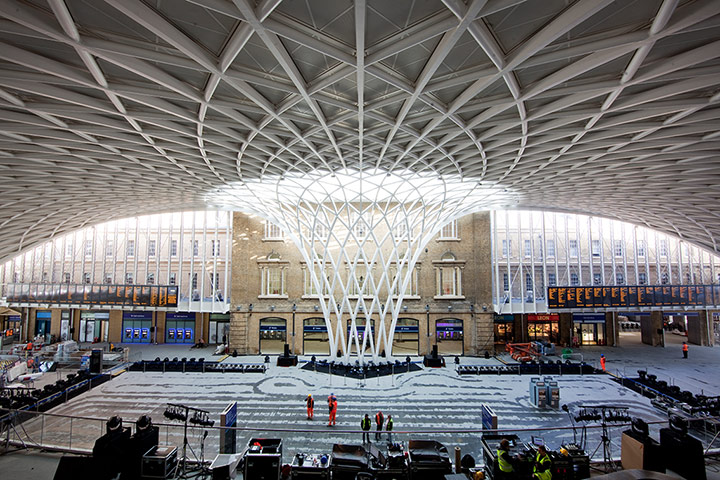Hi friends,
I have a massive backlog of theory writings that I have been meaning to share on this blog, but I don't want to bore you, my dear readers, with theory babble.
One thing that has come to my attention recently is the shift I have felt in my own design work. I consider myself a contextualist, approaching architecture as a social science set within an ever-evolving milieu of physical culture-driven phenomenon. While I like to explore design through whatever means most appropriately advances the concept I am pursuing, at Penn, I have dealt in more advanced techniques that before I would have considered outside my scope of knowledge-- not just in terms of project development (site analysis tools and conventions) but technologies. Software programs that I never thought I would dig into have actually been a balancing exercise for my usual manual-representation preferences.
 |
 |
Bringing this to a point: I think my obsession with acquiring new tools and proficiencies stems from a term that I read recently in a short (four page) article by Sanford Kwinter. Formalism. Before reading the article I would have defined formalism as
"a subjective act of craft, perception, or analysis resulting in an applied observation of an object in a given context." -me
Kwinter spins his definition of formalism a little differently:
"any method that diagrams the proliferation of fundamental resonances and demonstrates how these accumulate into figures of order and shape." -sk
 |
I believe that my newfound appreciation for these tools is actually a result of my own resonance and appreciation for alternative representation. I want to grow my skills to match the greatest capacity of the tools I am working with (digital for now). In short, the environment at PennDesign has encouraged me to break my DAAP Revit-and-colored-pencil chains and try new things. And since the tools at my disposal are parametric, system-centric, and meant to be largely iterative in nature, I have found myself gravitating toward these new technologies.
 |
Kwinter reminds us that "Formalism derives from this historic emergence of themes applied in a specific location at a specific time" (see above). This is where I am. The tools and strategies I am learning are such because of where I am learning them and the current themes of teaching.
BUT the bigger question is... through this formalism-- this acceptance of certain tools and skills-- am I compromising my core design beliefs? Those that allow me to approach architecture as a social science set within an ever-evolving milieu of physical culture-driven phenomenon. No, I don't think so. But there is something inherently humanitarian (that is, society-serving) and grounded (that is, buildable, constrained by ease of realization) that I have always perceived in my work, and I think I am beginning to expand that horizon.
 |
Find my reflections on a number of recent readings below:
SANFORD KWINTER
WHO'S AFRAID OF FORMALISM
To define formalism "any method that diagrams the proliferation of fundamental resonances and demonstrates how these accumulate into figures of order and shape." Kwinter's strongest argument presents form as a resonance and expression of embedded forces. Kwinter argues that true formalism is a pure translation-- a genetic evolution even-- of an object's rules of formation applied in a given time and place. To understand the form, we should always ask "why this object, institution, or configuration here, in this place, at this time, and not that?" Formalism derives from this historical emergence of themes applied in a specific location at a specific time.
ANTHONY VIDLER
THE THIRD TYPOLOGY
The "third type" of the city lends itself toward a closer consideration of architecture as a social vessel, each building contemporary to the time in which it was constructed. Rossi's reflection to Victor Hugo's quote from the 1830's, that "communication through printed word...has released architecture from the roe of 'social book' into its specialized domain."
Although architecture may no longer be a 'social book' it does frame the discussion of spatial organization in cities.
Understanding that buildings cannot present a regular and unified face in this new urban typology, we must see cities as fabrics. As webs of integrated and conversant urban components-- infrastructure, landscape, and shelter-- that is, systems, fields, and objects interwoven to create a coherent and integrated urban
 |
| The urban form has changed over time. Understand: URBAN itself is a typology for design |
GREG LYNN
ANIMATE FORM
Greg Lynn presents the development of visual technology from the perspective that architecture has long been static and is moving toward a state of motion, flow, and arrangement whose mathematical foundations are not cartesian or polygonal, but rather U/V-mesh and spline-based. This shift, he argues, takes architects from the topology-based model of 'stasis' to a model of 'shifting, shearing, rotation' and movement. Lynn questions the form of architecture that lasts forever, instead arguing for design that is 'built for obsolescence, dismantling, ruination, recycling, and abandonment through time.' These traits are rarely considered at the outset of an architectural project, but merit consideration, especially from the standpoint of adaptive reuse (considering how spaces and systems will be replaced over time) and the immense strides made in technology (how long will it be before houses have USB connections instead of electrical outlets?).
Regardless, Lynn's main discussion revolves around his argument for a redefinition of space from being neutral and timeless to being temporally dynamic. He explores how mathematics and 3D modeling programs allow for this process-- for designers can now apply advanced mathematical properties to their digital creations without ever needing to know the geometries and calculus that under-girds their explorations.


This comment has been removed by a blog administrator.
ReplyDelete